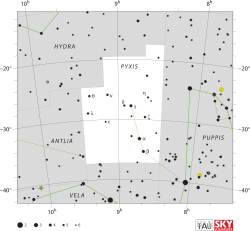
Summary
Lambda Pyxidis (λ Pyxidis) is a yellow-hued star in the southern constellation of Pyxis. It is visible to the naked eye, having an apparent visual magnitude of 4.68.[2] Based upon an annual parallax shift of 16.98 mas as seen from Earth,[1] it is located around 192 light years from the Sun.
| Observation data Epoch J2000.0 Equinox J2000.0 (ICRS) | |
|---|---|
| Constellation | Pyxis |
| Right ascension | 09h 23m 12.25099s[1] |
| Declination | −28° 50′ 01.9420″[1] |
| Apparent magnitude (V) | 4.68[2] |
| Characteristics | |
| Spectral type | G8.5 IIIb Fe−1[3] |
| U−B color index | +0.63[2] |
| B−V color index | +0.91[2] |
| Astrometry | |
| Radial velocity (Rv) | +10.2[4] km/s |
| Proper motion (μ) | RA: −128.25[1] mas/yr Dec.: +20.70[1] mas/yr |
| Parallax (π) | 16.98 ± 0.24 mas[1] |
| Distance | 192 ± 3 ly (58.9 ± 0.8 pc) |
| Absolute magnitude (MV) | +1.14[5] |
| Details | |
| Mass | 2.06[4] M☉ |
| Luminosity | 49[4] L☉ |
| Surface gravity (log g) | 3.04±0.06[6] cgs |
| Temperature | 5,126±22[6] K |
| Metallicity [Fe/H] | −0.05±0.02[6] dex |
| Rotational velocity (v sin i) | 4.4±0.2[5] km/s |
| Age | 1.3[4] Gyr |
| Other designations | |
| Database references | |
| SIMBAD | data |
Measurements of changes in the star's proper motion over time indicate this is an astrometric binary system. The visible component is an evolved G-type giant star with a stellar classification of G8.5 IIIb Fe−1[3] and a spectrum that displays an underabundance of iron with weak cyanogen lines.[8] It is a red clump star that is generating energy through the fusion of helium at its core.[9]
Lambda Pyxidis has double the mass of the Sun and is an estimated 1.3 billion years old.[4] It is radiating 49[4] times the Sun's luminosity from its photosphere at an effective temperature of 5,126 K.[6]
References edit
- ^ a b c d e f van Leeuwen, F. (2007), "Validation of the new Hipparcos reduction", Astronomy and Astrophysics, 474 (2): 653–664, arXiv:0708.1752, Bibcode:2007A&A...474..653V, doi:10.1051/0004-6361:20078357, S2CID 18759600.
- ^ a b c d Johnson, H. L.; et al. (1966), "UBVRIJKL photometry of the bright stars", Communications of the Lunar and Planetary Laboratory, 4 (99): 99, Bibcode:1966CoLPL...4...99J.
- ^ a b Keenan, Philip C.; McNeil, Raymond C. (1989), "The Perkins catalog of revised MK types for the cooler stars", Astrophysical Journal Supplement Series, 71: 245, Bibcode:1989ApJS...71..245K, doi:10.1086/191373.
- ^ a b c d e f Luck, R. Earle (2015), "Abundances in the Local Region. I. G and K Giants", The Astronomical Journal, 150 (3): 88, arXiv:1507.01466, Bibcode:2015AJ....150...88L, doi:10.1088/0004-6256/150/3/88, S2CID 118505114.
- ^ a b Ammler-von Eiff, Matthias; Reiners, Ansgar (June 2012), "New measurements of rotation and differential rotation in A-F stars: are there two populations of differentially rotating stars?", Astronomy & Astrophysics, 542: A116, arXiv:1204.2459, Bibcode:2012A&A...542A.116A, doi:10.1051/0004-6361/201118724, S2CID 53666672.
- ^ a b c d Alves, S.; et al. (April 2015), "Determination of the spectroscopic stellar parameters for 257 field giant stars", Monthly Notices of the Royal Astronomical Society, 448 (3): 2749–2765, arXiv:1503.02556, Bibcode:2015MNRAS.448.2749A, doi:10.1093/mnras/stv189, S2CID 119217930.
- ^ "lam Pyx". SIMBAD. Centre de données astronomiques de Strasbourg. Retrieved 2017-07-16.
{{cite web}}: CS1 maint: postscript (link) - ^ Luck, R. Earle (February 1991), "Chemical abundances for cyanogen-weak giants", Astrophysical Journal Supplement Series, 75: 579–610, Bibcode:1991ApJS...75..579L, doi:10.1086/191542
- ^ Alves, David R. (August 2000), "K-Band Calibration of the Red Clump Luminosity", The Astrophysical Journal, 539 (2): 732–741, arXiv:astro-ph/0003329, Bibcode:2000ApJ...539..732A, doi:10.1086/309278, S2CID 16673121.



